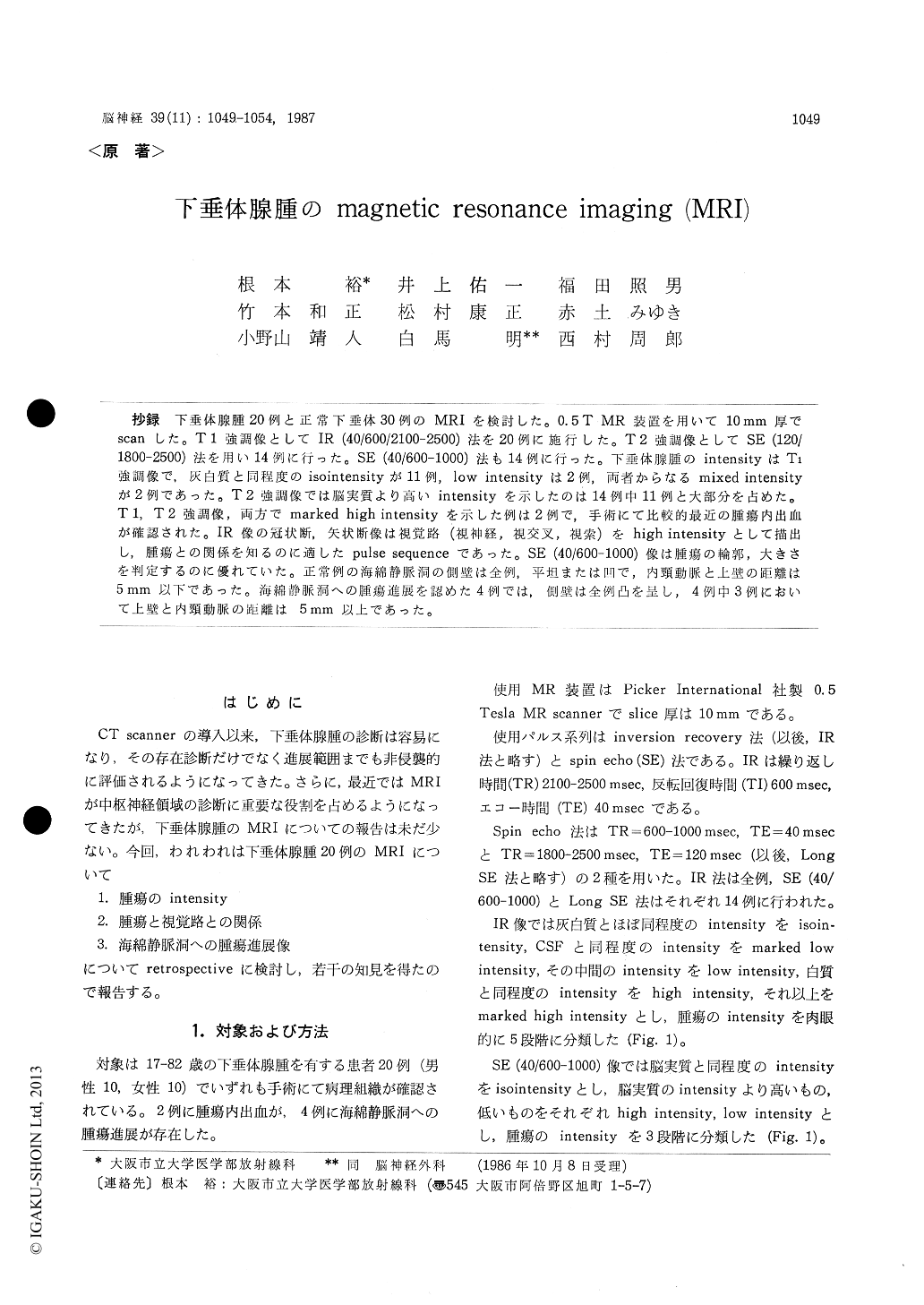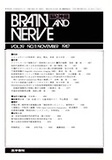Japanese
English
- 有料閲覧
- Abstract 文献概要
- 1ページ目 Look Inside
抄録 下垂体腺腫20例と正常下垂体30例のMRIを検討した。0.5T MR装置を用いて10 mm厚でscanした。T1強調像としてIR (40/600/2100-2500)法を20例に施行した。T2強調像としてSE (120/1800-2500)法を用い14例に行った。SE (40/600-1000)法も14例に行った。下垂体腺腫のintensityはT1強調像で,灰白質と同程度のisointensityが11例,low intensityは2例,両者からなるmixed intensityが2例であった。T2強調像では脳実質より高いintensityを示したのは14例中11例と大部分を占めた。T1,T2強調像,両方でmarked high intensityを示した例は2例で,手術にて比較的最近の腫瘍内出血が確認された。IR像の冠状断,矢状断像は視覚路(視神経,視交叉,視索)をhigh intensityとして描出し,腫瘍との関係を知るのに適したpulse sequenceであった。SE (40/600-1000)像は腫瘍の輪郭,大きさを判定するのに優れていた。正常例の海綿静脈洞の側壁は全例,平坦または凹で,内頸動脈と上壁の距離は5mm以下であった。海綿静脈洞への腫瘍進展を認めた4例では,側壁は全例凸を呈し,4例中3例において上壁と内頸動脈の距離は5mm以上であった。
MRI of 20 patients, 17-82 years old, with pitui-tary adenomas confirmed histopathologically, and 30 normal patients without pituitary dysfunction were reviewed. The studies were performed with a O.5 Tesla MR scanner with a slice thickness of 10 mm. Inversion recovery sequences were em-ployed as T1-weighted examination, with a repe-tition time (TR) of 2100-2500 msec, an inversion time (TI) of 600 msec and an echo time (TE) of 40 msec. The T 2-weighted examination had a TR of 1800-2500 msec and a TE of 120 msec. T1-weighted images were obtained in all cases and T 2-weighted images in 14 cases. Spin echo images with a TR of 600-1000 msec and a TE of 40 msec (SE 40/600-1000) were also obtained in 14 cases. On T 1-weighted images, 20 adenaomas were clas-sified into six groups, according to their signal intensities ; marked low intensity ( 1 ), low inten-sity ( 1 ), isointensity (11), high intensity ( 3 ), marked high intensity ( 1 ) and mixed intensity ( 3 ). On T2-weighted images, 14 adenomas were classified into five groups ; low intensity ( 1 ), isointensity ( 2 ), high intensity ( 4 ), marked high intensity ( 6 ) and mixed intensity ( 1 ). On SE 40/600-1000 images, 14 adenomas were also classi-fied into four groups ; low intensity ( 8 ), high intensity ( 2 ) and mixed intensity ( 3 ). Two ade-nomas with recent intratumoral hemorrhage had marked high intensity on both T1 and T2-weighted images. SE 40/600-1000 images were useful in evaluating the size and the extent of the tumors. Relation between the tumor and the visual pathway was best appreciated on IR images.
Comparison between normal and involved caver-nous sinus by adenomas was made. The normal cavernous sinus had a flat or concave lateral wall, and a distance less than 5 mm from the internal carotid artery to the superior wall of the cavernous sinus. All 4 cases of the cavernous sinus involved by a pituitary adenoma had a covex lateral wall. Three out of 4 had a distance more than 5 mm from the internal carotid artery to the superior wall. Knowledge of relation between the tumors and surrounding structures changes the treatment plan-ning and makes the surgical procedure easier.

Copyright © 1987, Igaku-Shoin Ltd. All rights reserved.


